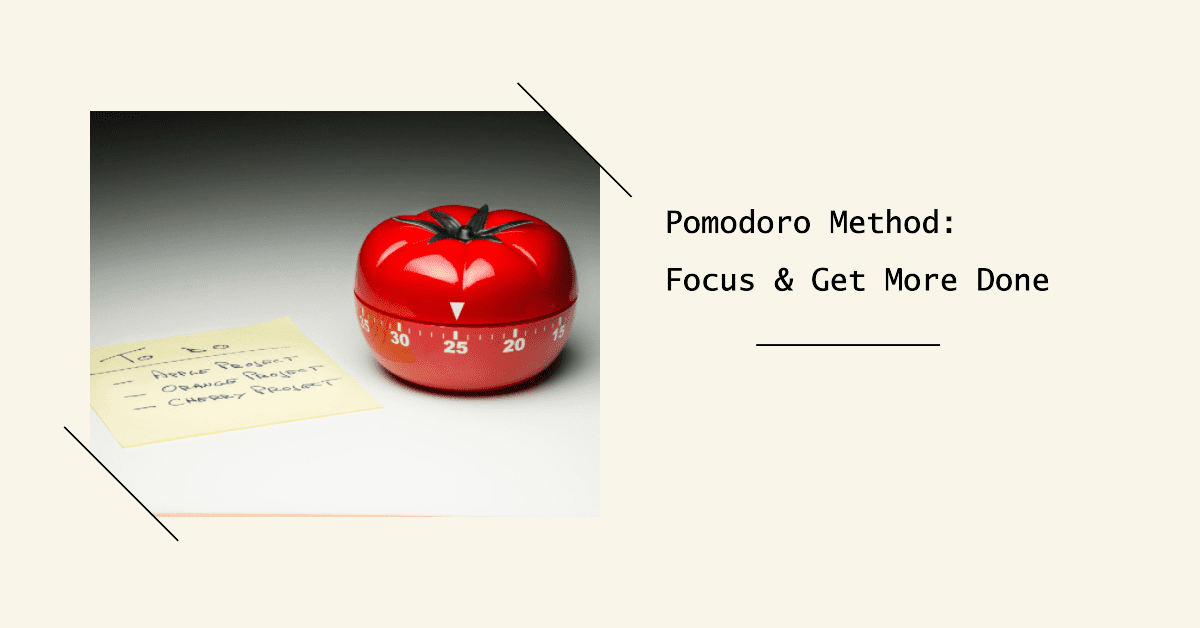How To Use The Pomodoro Method To Focus More And Get More Done
Are you someone who struggles with time management, finds it difficult to stay focused, and often ends up procrastinating? Well, I can relate to you, it’s challenging to focus and stay productive. That’s why I use the Pomodoro method, a time management technique that works wonders for me.
Improving your focus and productivity can seem impossible when you have a million tasks on your to-do list. If you’re looking for an easy way to stay on track, the Pomodoro Method might be the answer. This technique has been around since the 1980s, but it’s still as useful today as it was then. It can help you maximize your focus and get more done in less time. In this article, we’ll explore exactly how to use the Pomodoro Method so that you can become more productive and focused!
What Is The Pomodoro Method?
The Pomodoro Method is a popular productivity technique used to manage time and help increase focus. It was created by Francesco Cirillo in the late 1980s and has been used by countless people around the world to improve their productivity. The method consists of breaking down tasks into intervals, typically 25 minutes in length, separated by short breaks.
To use the Pomodoro Method effectively, it’s important to have a clear goal or task to work on during each interval. During this time, one should focus exclusively on the task at hand while eliminating distractions such as email notifications and social media. After each interval, one should take a short break (no more than 5 minutes) before beginning another interval. This technique can help keep one focused and motivated while completing tasks in an efficient manner.
Setting Up Your Timer
Visualize a timer with minutes ticking away. The ticking of the seconds is like a metronome, guiding and helping you stay focused on your task at hand. Setting up the Pomodoro Method for yourself can help you get more done in less time.
Begin by deciding what type of timer to use. You might prefer an app, a kitchen timer, or a digital timer. Whatever works best for you is what you should choose. Set the timer for 25 minutes and start working on your project without any distractions. When the timer dings, take a five-minute break and then reset it for another 25 minutes and continue working. After four sessions, take a longer break; about 15-30 minutes will do. Return to your project refreshed and ready to focus on completing it!
Defining Your Tasks
Once you’ve set up your timer, the next step is to define the tasks you want to complete. Start by breaking down large tasks into smaller chunks and setting reasonable goals. For example, if you need to write an essay, break it down into smaller sections such as research, outlining, writing a rough draft, and editing. This will make the task more manageable and will help you focus on one section at a time.
Prioritize tasks that require more energy and focus for when your energy levels are highest. That way, when your energy begins to wane during a session, you can move on to simpler tasks that don’t require as much mental effort. Doing this gives you the satisfaction of completing multiple tasks in one sitting while also keeping your motivation high.
Working In 25-Minute Intervals
Time management can be overwhelming and often feel impossible, especially when juggling multiple tasks. But with the Pomodoro Method, it can be much simpler to stay focused and get things done. Working in 25-minute intervals helps break down large tasks into more manageable chunks of work, providing an easier way to stay concentrated and improve productivity.
By setting a timer for 25 minutes and focusing on the task at hand until the timer runs out, you can stay motivated while staying on track. You can also give yourself short breaks in between each interval to help your brain relax and recharge. This can help reduce mental fatigue so that you remain productive throughout the day.
Taking Breaks Between Sessions
Now that you’ve set up your interval timer and determined what tasks you’ll complete during each 25-minute session, it’s time to turn our attention to taking breaks between these sessions. Breaks are an essential part of the Pomodoro Method; they give your mind a chance to reset, allowing you to focus more effectively when beginning subsequent 25-minute sessions.
It’s important to take your breaks seriously – don’t just spend them scrolling through social media or playing games on your phone. Try activities like walking around the block, reading a book, or doing some light stretching. Taking short breaks away from electronic devices can help clear your head and boost creativity. When you come back to work after taking a break, you should feel refreshed and ready to tackle the next task on your list.
Making It Simple & Effective: Breaking the Pomodoro Method Down Into Steps
Step 1: Plan Your Work
The first step in using the Pomodoro method is to plan your work. Before beginning your Pomodoro session, take a moment to outline what you need to accomplish. Jot down all the essential tasks that you need to complete, prioritize them, and break them down into smaller, more manageable chunks. This will help you to stay focused and avoid getting distracted by other tasks.
Step 2: Set a Timer
Once you have your list, set a timer for 25 minutes and start your first Pomodoro session. During this time, you need to solely focus on your work, avoid any distractions, and do not let any disruptive thoughts cloud your mind. I have found that using a manual timer works best for me to avoid distractions on my phone and to make the time limit seem more real.
Step 3: Take a Break
After 25 minutes of hard work, take a short break of 3 to 5 minutes. It’s time to do something that is unrelated to the task at hand. Stand up, walk around, stretch a bit, or listen to your favourite song. The idea is to take your mind off the work at hand and recharge your batteries.
Step 4: Repeat
Repeat this process of working for 25 minutes and taking a short break until you have completed four Pomodoro sessions. After these four sessions, take a longer break of 15 to 30 minutes. This will help you recharge your energy levels and help you avoid burnout.
Step 5: Personalize Your Timing
Everyone’s body works differently, and therefore, there is no definitive answer to how long you should work and how long breaks you should take. Some people find that they work best with shorter or longer Pomodoro sessions. Experiment with different timings until you find the ones that suit you best.
Step 6: Eliminate Distractions
Distractions are everywhere, be it social media notifications, random calls or messages, or anything else that could divert your attention from your work. To get the most out of your Pomodoro sessions, it’s critical to eliminate any potential distractions completely. Turn off your phone, close your email, and avoid any other distractions that may interrupt your work.
Step 7: Promote Classical Conditioning
Classical conditioning means creating a habit of associating a particular stimulus with a particular action. In the case of Pomodoro sessions, using the same timer for each Pomodoro session can help promote this classical conditioning. Or perhaps you could use the same laptop to work on that is only used for your tasks at hand with limited access to apps or websites that may cause distractions. Over time, your mind will start to associate the timer with the action of working, resulting in improved focus and productivity.
Step 8: Gamify Your Studying
Gamify your studying by using apps like Forest Timer. These apps use gamification to motivate you to stay focused during your Pomodoro sessions. In the Forest Timer app, as you complete more Pomodoro sessions without checking your phone, you’ll begin to grow a digital forest with every session completed.
Step 9: Use Music
Music can be an excellent tool for improving focus and concentration. However, it’s essential to choose the right type of music. Choose non-intrusive music that is appropriate for the task at hand, and try to adjust the music based on the difficulty of the task at hand. Personally, I prefer using instrumental music because it helps me stay focused and reduces the possibility of distraction.
Step 10: Use the Pomodoro Method Correctly
Like any technique or tool, the Pomodoro method can only be advantageous if you use it correctly. Staying focused, avoiding distractions, personalizing your timing, promoting classical conditioning, and using the technique consistently are all vital aspects of successfully using the Pomodoro method. If you use it correctly, the Pomodoro method can help you to focus more and get more done.
Frequently Asked Questions
How Often Should I Use The Pomodoro Method?
The frequency at which you use the Pomodoro Method depends on the individual. Some people may find that using it for every task works best, while others may prefer to use it only when they need a burst of energy or extra focus. It’s important to experiment and find out what works best for you. For example, if you get distracted easily, a shorter Pomodoro session might be better than a longer one.
What Happens If I Can’t Finish A Task In 25 Minutes?
If you can’t finish a task in 25 minutes with the Pomodoro method, don’t be too hard on yourself. It’s important to remember that this method is meant to help you focus and improve your productivity, so if it doesn’t work out for a particular task, that’s okay. You can always try again later and adjust the amount of time needed for each task.
Does The Pomodoro Method Help With Procrastination?
The Pomodoro Method is a popular time-management technique designed to help reduce procrastination. It works by breaking down tasks into 25-minute intervals, with short breaks in between. By giving yourself a set amount of time to focus on the task at hand, it can help keep you motivated and on track. In addition, it’s also helpful for tracking how productive you’ve been over time and making sure that you’re not spending too much time on one task. While the Pomodoro Technique won’t necessarily cure procrastination completely, it can be an effective tool for staying focused and getting more done in less time.
Is It Necessary To Take Breaks Between Sessions?
Yes, it is necessary to take breaks between Pomodoro sessions. The Pomodoro Technique was designed so that users take a break after every 25 minutes of focused work. This helps to prevent mental fatigue and gives your mind time to rest and recharge, which increases productivity over the course of the day. Taking regular breaks also helps to prevent procrastination and boost motivation, ensuring maximum focus throughout each session.
Is There A Way To Adjust The Pomodoro Method To My Own Needs?
The Pomodoro Method can be adjusted to fit an individual’s own needs. This popular time management technique encourages taking regular breaks after 25 minutes of focused work, with a 15-minute break for every 4 ‘pomodoros’. However, this is flexible and you can adjust the length of the work and break periods to best meet your requirements. For example, if you need longer periods of focused work before taking a break, you could extend the pomodoro period to 50 minutes instead of 25.
Conclusion
Using the Pomodoro Method is a great way to stay focused and get more done. It takes some practice, but once you get used to it, you’ll be amazed at how much more productive you become. It’s important to remember that everyone has different needs and preferences, so take the time to adjust the Pomodoro Method to what works best for you. With some commitment and consistency, you’ll be seeing results in no time. Good luck!










